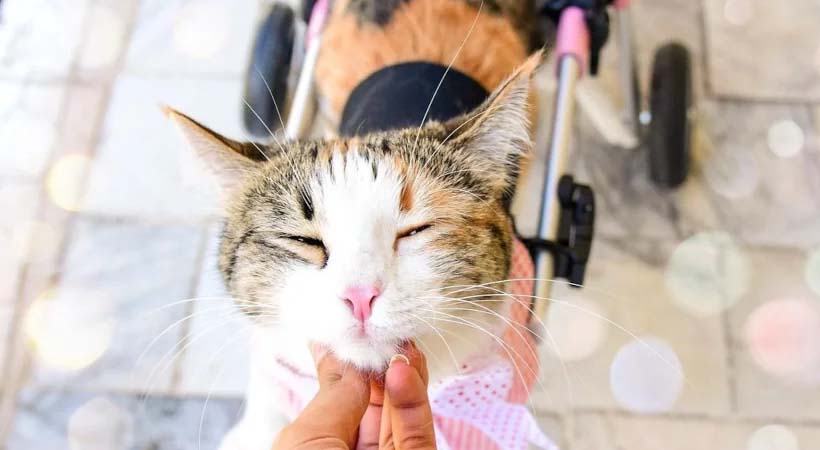Beagle Lifespan: How Long Do Beagles Live? (Life Expectancy)

Everything You Need to Know About Paralysis in Cats
What is Cat Paralysis?
Paralysis in cats occurs when a cat is unable to control one or all of their legs or another part of its body. When a cat is paralyzed they are likely unable to walk, stand, or support themselves without assistance.
Other signs of cat paralysis include: an inability to move different parts of the body, a stumbling gait, twitching, lethargy, and incontinence. Cats experiencing partial paralysis are more likely to twitch uncontrollably or move very slowly.
Oftentimes, paralysis occurs due to an underlying health condition or as a result of a traumatic injury. A full physical examination by your veterinarian will be needed to determine the cause of your cat’s paralysis.
Causes of Paralysis in Cats
Hind leg paralysis in cats can be caused by a number of underlying health issues.

- Lymphoma or tumors in the spine or brain
- Traumatic injury
- Infection in the bone or spine
- Spinal inflammation
- Slipped disc in the spinal cord or intervertebral disc disease
- Tick paralysis in cats - caused by a toxin released by a tick bite directly impacts the nervous system causing paralysis.
- Radial nerve paralysis - typically caused by nerve injury. Radial nerve paralysis impacts mobility in the neck, shoulder, and a cat’s front legs.
- Spinal malformation
- Embolism which restricts blood flow to a limb
- Tetanus
The only way to determine the reason why your cat is paralyzed is to bring them to the veterinarian for a full physical examination. During the exam, your vet will assess the location and severity of the injury as well as advice you on the treatment plan. Possible treatments may include antibiotics, anti-inflammatory medication to reduce spinal pressure and crate rest.
Dealing With Sudden Paralysis in a Cat's Back Legs
Damage to the spinal nerves is the leading cause of sudden paralysis in a cat's back legs. Jumping from a significant height and landing badly is a common way that cat’s injure their spine and is a leading cause of feline paralysis. The cat’s spine is made up of 24 different bones in the vertebrae. Any unexpected shift in the intervertebral discs or the cushions in-between can potentially impact a cat’s mobility. Paralysis occurs when a slipped disc presses against your cat’s spine and compresses the spinal nerves which disrupts the communication between the nerves and the brain to impact motor function. In some cases the cat will be unable to move their legs and other times it will result in partial paralysis causing weakness in the legs.
Laryngeal Paralysis in Cats
Although rare in cats, paralysis can impact just the larynx. Laryngeal paralysis impacts the functionality of a cat’s upper airway and stops the larynx from opening and closing properly while a cat breathes. Along with struggling to breathe, cats with laryngeal paralysis will have a dry cough, noisy breathing, and changes in their voice.
Urinary Incontinence in Paralyzed Cats
Paralyzed cats often struggle with incontinence. Unable to pee on their own, or control their own bladder many pet owners have to express their cat’s bladder manually. A healthy feline bladder will need to be expressed routinely throughout the day to avoid possible infection. Most incontinent cats need their bladder expressed at least three times a day.
It takes a bit of practice, but most cat parents learn how to express their cat’s bladder very quickly. You need to locate the bladder and gently squeeze the full bladder so that the urine moves through the urethra and out of the cat’s body. You need to express the bladder fully to ensure all urine comes out to avoid bladder infection or UTI. It may take several squeezes to fully empty the bladder. An empty bladder should feel about the same size as a grape.
Recovery from Cat Paralysis

It is possible to recover from cat paralysis, but every cat’s prognosis is different. In the most severe cases and more drastic injury, it's possible that a cat can be paralyzed for the rest of their life. A permanently paralyzed cat may rely on a cat wheelchair for continued mobility.
Cat wheelchairs provide support and stability, so that your cat can enjoy a normal, active lifestyle and maintain their independence. You can greatly improve your cat’s recovery by ensuring they get proper medical care, following all guidelines your vet gives you, and working step-by-step through the rehabilitation process. Recovery for most injuries should take between one to two months.
It's important to remember, every cat's recovery process is different. Be patient and follow the guidance of your vet.
Benefits of a Cat Wheelchair
Mobility assistance from a cat wheelchair can help maintain a cat's independent spirit and allow them to get the exercise they need. A cat cart are lightweight and provide the support and stability your cat needs to walk. Carts allow paralyzed and disabled cats to move on their own again as well as run, play, and engage with their family. Wheelchair benefits include:
- Improve quality of life
- Improve mental health, an active cat is a happy cat!
- Help cats to stand upright and improve physical health
- Maintain muscle tone and build up strength
- Use the wheelchair as a rehabilitative tool
- A full support cat wheelchair is available for cats dealing with both front and rear leg weakness
Ask you veterinarian or rehab professional if a cat wheelchair is right for your pet.
Related Articles:









